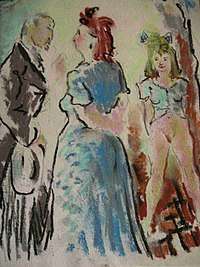Constant Detré
Constant Detré (Szilárd Eduard Diettmann) was born in Budapest (then a part of the Austro-Hungarian Empire) on 2 January 1891, and died 10 April 1945 in Garnat-sur-Engièvre a village of central France (département of Allier). He was an artist who left his native Hungary for good in rather obscure circumstances following the repression against the Béla Kun government of 1919. He settled in Paris where he mixed from 1920 to 1940 with representatives of the School of Paris and other Montparnasse artists, several of whom were Central European émigrés like himself, such as Pascin, a good friend of his.
Constant Detré | |
|---|---|
%2C_photograph.jpg) Constant Detré | |
| Born | Szilárd Eduard Diettmann 2 January 1891 Paris, France |
| Died | 10 April 1945 (aged 54) Paris, France |
| Nationality | Hungarian, French |
| Known for | Painting |
| Movement | Post-Impressionism, Art Nouveau, School of Paris |
Early life
For lack of extensive data, the artist’s biography is difficult to piece together. It has been ascertained with some degree of confidence that his forebears were all in varying degrees artists from Central Europe. His great-grandfather Clémens Dittmann was a sculptor who moved from Vienna to Budapest early during the 19th century, where he worked on several important buildings.[1] His grandfather Eduard Diettmann (Dittmann) was a sculptor who married a Hungarian woman.[2] Constant Detré's father, Eduard Diettmann,[3] a steam engine mechanic, died too early to make a name for himself as an artist.[4]
Detré studied painting in Munich with one of the greatest Hungarian representatives of 19th century Naturalism and Realism, the Hungarian artist Simon Hollósy, who organized study sessions in the Carpathian Mountains for his students at the private painting school he had founded in the Bavarian capital in 1886.[5]
Career

Detré went to Paris in 1914, before returning to Hungary, but would leave shortly thereafter, perhaps as a result of the brutal anti-communist repression launched by the Miklós Horthy regime. (A member of Detré's future wife's family, it was rumored, served as an "artistic advisor" in the government of Béla Kun) but if so, it was not by official decree. In 1919 Detré returned to Munich and became the producer of a pantomime company. He moved to Paris in time for the 1925 Exposition Internationale des Arts Décoratifs et Industriels Modernes (International Exposition of Modern Decorative and Industrial Arts). He became an acquaintance of Henri Matisse, Raoul Dufy, Tsuguharu Foujita, Moïse Kisling, Kiki de Montparnasse (who modeled for him on several occasions) and a close friend of Pascin.[6]
His first marriage with the Hungarian Marie Mirkovsky[7] ended in a divorce. On 30 December 1933 he married Claire Carnat, a young talented artist (and puppet designer) from a well-to-do French family. He became a naturalized French citizen shortly before World War II, on 27 November 1936.
Detré worked as a professor at the Académie Julian, teaching life drawing, art of fashion, composition, color harmony, model creation, theater art, costume design, theater history, decor, stage sets, modeling, and in situ studies at theaters throughout Paris.[8]
His ink drawings ("Miseries" and "Cannon Merchants") represent his indignant reaction against all forms of prevailing injustices. He illustrated books (Zola’s Thérèse Raquin). Like Toulouse-Lautrec, he was attracted to brothels, as is evident in his so-called Dessins à la Lanterne (lantern drawings), reflecting the mood, feeling, and his ability to understand the Parisian atmosphere during the 1920s and 1930s in Paris.
Detré's pastels (his favourite medium) show great virtuosity and originality. Subjects vary from trenchant social criticism to colorful landscapes, portraits, domestic and brothel scenes not unlike those of Toulouse-Lautrec whose influence he recognized. Yet he has his own way of treating his subject-matter, with ordinary everyday scenes, peopled with nonchalant, sometimes withdrawn, but always vibrant characters. Occasionally he paints himself as a voyeur gazing from within the canvas at his unsuspecting models, so that we feel drawn into his world as if we were his accomplices. His work is rarely found in auction houses and even less so in museums. In the 1960s, a number of works were placed in public auctions at Hôtel Drouot, Paris, and elsewhere, by the artist's family and his only daughter so that examples of his production continue to delight private collectors, in Europe and possibly other places.[9]
His only daughter, in a last-ditch attempt to bring her father's life and work to the notice of all art lovers and experts who have for so long and unjustly neglected to consider her father on a par with his better-known contemporaries, has designed a website in his memory and collected all sorts of written testimonials, with reproductions of some of his best art work in a beautifully produced book (in French only) [10].
Notes and references
- Catholic Church of de Budapest-Ferencvàros. Karoly Palace: one of the most important classical buildings of the 5th district of Budapest, edified in 1822. The amphitheatre of the National Theatre (1837).
- A particularity of the Diettmanns was that the males were Evangelical Protestants (Lutherans) while the females were Catholics: for each wedding a dispensation was required in order to conduct the wedding ceremony at the Evangelical church of Deàk square, Budapest.
- Around that time the letter E appears in the Diettmann surname.
- Constant Detré, Life
- Maurice Henrion, Treasurer of the French Foreign Critique (Trésorier de la Critique Etrangère de France)
- Maurice Henrion, Maître Pajot, Commissaire-Priseur, Fontainebleau, sale catalogue Peintures du XIXe siècle, Sunday, 16 April 1961
- Detré's first wife, Marie Mirkovsky, is thought to have been a dancer from Budapest
- Constant Detré, Julian Academy in Paris
- Constant Detré, Catalogues of Public sales and another documents, 1961 and 1962 sales (Fontainebleau, France)
- Constant Detré, Artiste Peintre Pastelliste par Marie-Claire Diettmann-Coutan, sa fille, ISBN 9782957172108
External links
- Constant Detré Original version, in both French and English, revised by the artist's daughter
- Constant Detré